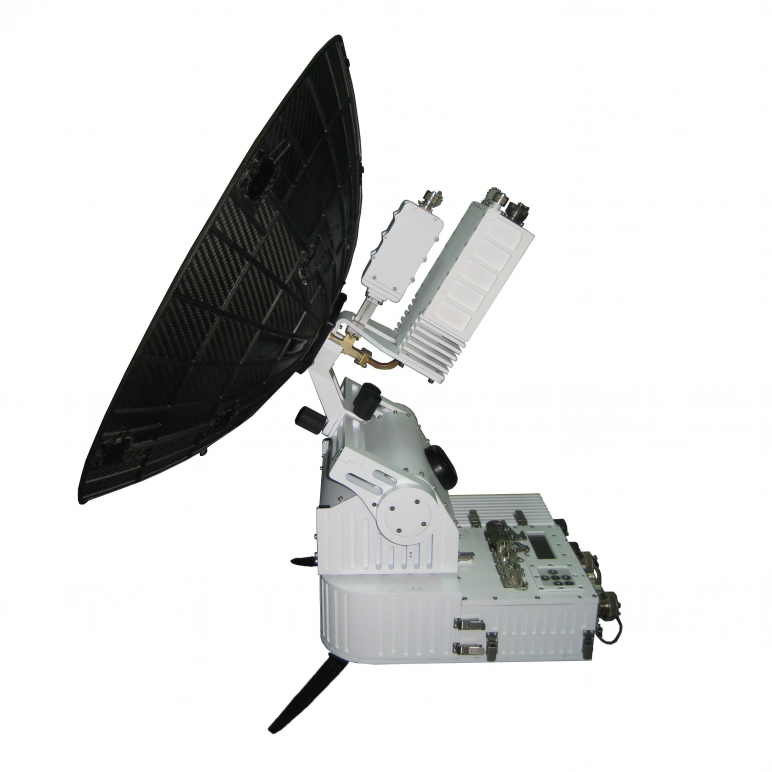-
StatusCompleted
-
Status date2014-12-16
The demand for Ka band services and therefore products has emerged as a way to satisfy the ever increasing data rate requirements. In many cases, this connectivity is required for nomadic users, and therefore, there is a growing demand for quick deploy terminals, for applications such as fast news gathering transmission (FNG).
The main objective of this project is the development of a Ka band fly away bidirectional terminal in order to cover near future market demands, with the following characteristics:
- Excellent radioelectric performance
- Compact design for fast and easy transportation and deployment
- Flexible configuration upon user’s needs
- Wide application range terminal
- Robust design to work under hard environmental conditions
It will be light weight, allowing the user to stow it for transportation and deploy at the desired site in a fast and easy way. The system will be IATA compliant airline checkable. The size constraint will be a key factor for the terminal design. In order to ease the system’s operation, a motorized terminal is proposed
The main objective of this project is the development and industrialization of a Ka band fly-away cost-effective terminal with excellent radiofrequency performance, very compact, easy to transport and deploy.
Several challenges are derived, amongst them:
- Ka band antenna and RF design and development.
- Pointing accuracy of the terminal. Operation at Ka band requires higher accuracy than former X or Ku terminals, demanding higher precision in the mechanical and motorization stages, including SW control strategies.
- Environmental requirements compliance, as the terminal is intended for hard weather conditions including rain, dust or operation at wide temperature range.
Nowadays there is a great demand for Ka band services. Market research studies indicate that there is an important market opportunity for Ka band Fly-Away terminals.
ACORDE is a world leader in the Ka band earth segment equipment market and will be well positioned for integration, testing and commercialization of the developed terminal.
The Fly-Away terminal to be developed within this project will have a multiplier effect for the company.
The following added benefits can be highlighted:
- Technical capabilities increase, enhancing complete system’s design and integration
- Access to new markets and new type of customers
- Commercial network increase
The Ka band fly-away terminal to be designed, manufactured, tested and industrialized is composed of the following subsystems:
- Ka band Antenna Subsystem
The antenna is composed of main reflector and illumination system, with septum polarizer, cylindrical waveguide, feed and splash.
- Ka Band RF Subsystem
This Subsystem is comprised of the RF elements, Transmit Reject Filter (TRF), Low Noise Block (LNB) and Block Up Converter (BUC)
- ACU Subsystem
The pointing subsystem consists of driving mechanisms to orientate the system. This subsystem is designed to be integrated in the base of the antenna.
- M&C Subsystem
This subsystem is responsible for the processing, distribution, monitoring and control related task, both inside the terminal or coming from the M&C software installed in the external laptop. This subsystem will also distribute the AC and DC power among the rest of the elements of the system.
- Power supply Subsystem
A solution based on an external power supply is to be designed. This configuration gives the user the possibility to replace the power supply by a spare unit under malfunctioning situations, locally in a fast and easy way without the need to send the terminal to ACORDE.
- Modem
The system is for the modem to be fully integrated in the fly-away terminal. The baseband hardware configuration will be flexible, and therefore, its setup will be adaptable to the application or user needs. This mainly affects the satellite modem to be integrated, which will be user selected.
In any case, the RJ45 interfaces enable for the connection to external devices and to other LANs.

The project plan includes management and reporting, terminal specification definition, terminal design, terminal components implementation, prototype integration, prototype testing and demonstration, industrialization, intensive testing, certification and pre-series development. The project has been divided into six blocks, named work packages. The work packages have also been divided into tasks and seven major milestones have been identified.
During the final stage of the project, a second unit has been developed.
According to the potential improvements identified in the previous project stage, mechanical elements have been modified to decrease the total net weight and to improve the compactness and level of integration of the terminal developed in this stage. Those improvements make it possible to transport the system in only one IATA compliant case with a gross weight less than 32 Kg.
Besides, the antenna feed has also been modified to improve the axial ratio specification and sidelobe performance. A second round of range testing has been performed as well.
The terminal developed in this stage has successfully undergone an intensive environmental testing campaign defined by MIL-STD-810F standard as well as CE marking testing at an external accredited lab.
As a result of this project, a bidirectional compact Fly Away terminal ready for market has been successfully developed.



